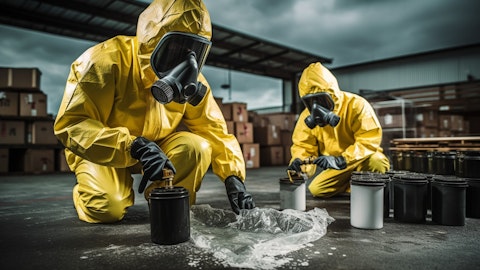Mark Duff: No, not really, Walter. We are we are not burning it. Burning it has been largely banned, in other words, incineration by DOE and DOD. And the reason they banned it was because of the potential for putting PFAS in the air and the amount — the difficulty in controlling that. Our approach is using chemistry. And with a strong potential and we’re developing this now and I’ll let Lou jump in if he’s got much to add something here, that we can recycle some of the chemicals we’re using in our system. That’s kind of phase two of our technology demonstration. That would literally pretty much eliminate all the effluent concerns that other technologies have. So the heat will certainly and pressure will certainly accelerate the chemical reactions we need to occur, but there’s no off gas, which is what you’d get if you burned it. Lou, is there anything you want to add to that?
Louis Centofanti: Yes, it’s a very simple process, basically done in a sealed container. Take the liquids, dump in our special materials, sit for a couple hours with some temperature and everything’s gone. Everything we’ve screened it on, every floor carbon we screened it on has, the system destroys it even Teflon. So we are very excited about it. It has lots of application — potential applications, like Mark has said, the number one application initially that we see the low-hanging fruit is the liquids, either from old materials sitting out there or some of the separation processes that are starting to be used for groundwater, cleanup of that. So we see a very large potential market in several different areas. The first one being liquids, and then we’ll look to — we’re continuing to look at all the other potential applications of the system. We see a lot of application — potential applications.
Walter Schenker: Thanks. By the way, hi, Lou.
Louis Centofanti: Hey, Walter. How are you?
Walter Schenker: And therefore, since I was the first time, this market is again potentially billions of dollars or tens of billions of dollars. And Perma-Fix is a very small company and it’s nice to do a couple of millions or even tens of millions, but that’s an almost insignificant against billions. Therefore, it is possible or likely on a longer-term basis that you could license this one of the very large players.
Louis Centofanti: We’ve kept every option open on how we grow this. The first real obvious since we have facilities that are licensed and permitted and all of this. The liquids one is a very simple starting point for us where we can learn more about the technology. But we are looking at all the above. There’s a lot of on-site work that could be — this process could be used that. And we’ve talked to a variety of larger companies that might be interested in working with us, especially with the on-site market. So yes, you’re exact — we’re keeping all options open at the moment for how do we apply this and what route we take.
Operator: Your next question for today is from Brian Russo with Sidoti.
Brian Russo: Yeah, hi. Just wanted to follow up on the Rev. 10 document and grouting, what are the next steps for DOE or any milestones that we should look out for? Not in terms of Perma-Fix’s role because you have a very strong position but just timing on when this scenario could accelerate.
Mark Duff: Thanks for your question, Brian. What it comes down to is my initial answer to that is that the tank removal systems have to be procured and installed. And we met with a firm just yesterday that is one of the players in that market and they are in competition now. I think the submittals for those proposals is in within days of now. I’m not sure when exactly, but it’s very, very soon. And then they’ll make an award. And I’m speculating on exactly the date, but in the next several months, likely in our Q3, and then the milestones for fabrication, construction, and implementation of those removal systems will occur over the next year. So the milestones that used to track that is really when DOE will be capable of removing the waste.
And the interesting part is the one removal system will feed the DFLAW, I mentioned. There’s an infrastructure, a piping on the east side tank farms that will be used to feed the DFLAW plant. On the West side tank farms, which is just about 50% as I mentioned, there’s no infrastructure. So we pretty much move the system from tank to tank to tank and then start pumping into totes because there’s no piping infrastructure. And those totes will be delivered to the treatment facility. So it’s a lot simpler, more flexible, and can move very rapidly. So I see that the primary milestones associated with that tank removal system that we mentioned.
Brian Russo: Okay, great. And can you just elaborate on the European expansion strategy? You mentioned the JRC earlier and the 10 million of waste shipments that could ramp up thinking later in 2024. Any more developments on the of the UK Westinghouse facility?





